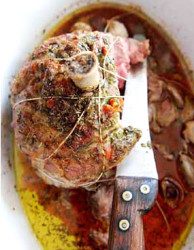
The essential keys to cooking meats are both being very attentive and a careful control of cooking temperature. Meats can overcook and dry out in a matter of minutes.
Don’t rely on recipe cooking times or simple formulas
Don’t rely only on the cooking times prescribed in recipes books because they don’t always guaranty a successful cooking. Recipes can’t account for significant changes in cooking time caused by small variations in meat thickness, temperature, and the temperature of grills and ovens and pans and so on.
Bring most meats to room temperature beforehand
Don’t lay your steak on the hot pan directly from the refrigerator. Bring most meats to room temperature or even warmer before cooking. This reduces cooking times a lot and the usual surface being overcooked when the inside just gets heat. The only case you can cook meat cuts directly from the refrigerator is when cuts are thin, to give the surface time to brown, but not more.
Cook large pieces of meat, on the bone when possible
Larger pieces of meat and meat on the bone are better because they to retain the most moisture and flavor. The more meat is cut up, the more surfaces it has through which juices will get squeezed out.
Cook most meats in two steps
Step one: cooking at very high heat kills surface bacteria,browns and flavors the meat surface. Step two: a finishing period of low and controlled heat cooks the meat through slowly and gently while preserving its moistness and tenderness. Keep the finishing cook-through as close as possible to the final inner temperature you want. Think that meat continues cooking when you get it off the stove or oven, so this time is to take into account, especially for thin cuts.
Check meat doneness early and often
If you’re using a thermometer, check its accuracy beforehand. Here are some popular cooking thermometer on Amazon.
When cooking at high temperatures
As stated above, stop cooking when meat is still slightly underdone. The hot surface will continue to heat the inside for some more time.
To cook tender cuts so that they’re juicy
To cook tender cuts so that they stay juicy, heat them until rare or medium rare, which correspond to an inner temperature of 125 – 140°f (52 and 60°c). This is where your probe thermometer will be your best friend.
Tenderloin, steaks and pork chops and ground meats are tender cuts. Chicken and turkey breasts have not as much juice but they are more pleasing at slightly higher cooking temperatures, around 150°f (65°c).
Cooking tough cuts “relatively quickly”
To cook tough cuts like pork shoulders, chuck roasts, and pork and beef cheeks relatively quickly, so while being dry and fibrous meat, they’re still tender when serving. You have to heat them to an inner temperature of 180 – 200°f (80 to 90°c). This cooking method helps to produce a tender meat in 2 to 12h, depending on the temperature and the cut (how said “slow cooking”?). It works best with cuts rich in gelatin and fat, which can lend moistness to the dry meat fibers.
Cooking tough cuts to keep them tender and juicy
Cook tough cuts so that they’re tender and their fibers retain some juiciness is not an impossible task. Heat them to an internal temperature of 140 – 160°f (60-70°c). This modern method will require cooking for 12 up to 24 hours or more to totally dissolve connective tissue into gelatin and produce a tender meat.
How to cook ground meats, pâtés and terrines, and fresh sausages
Cook them same way as tender meats, briefly and moderately to retain all their juice. To clear out fresh sausages from any bacteria, poach them first in boiling water for 20-30 minutes. Then drain and cool them briefly. Season their surface quickly over the high heat of the grill or frying pan. Cooking is not required for cured or precooked sausages, same for prepared pâtés or terrines.

